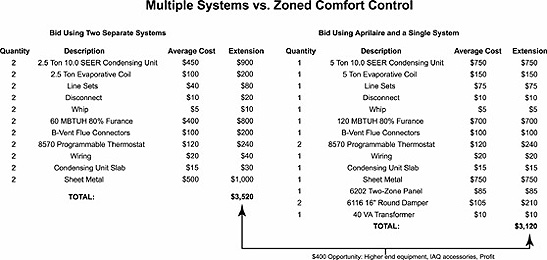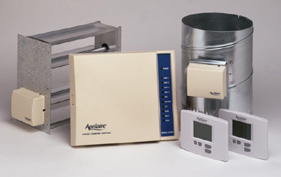Early residential zone control systems were not much more than a set of relays that would perform the function of closing dampers while simultaneously turning on the heating and cooling equipment. There was no built-in equipment protection, no indicator lights for troubleshooting, and early dampers were typically more prone to failure, creating frustration for HVAC contractors. No wonder early zone control systems gave zoning a black eye and in many cases drove contractors to an even more primitive method of zoning - installing multiple HVAC systems in a home.
Times Have Changed
Modern zoned comfort control systems employ the latest in electronics technology and care as much for the contractor's installation needs as the homeowner's comfort and convenience.Contractors will appreciate systems that provide equipment short-cycle protection and plenum temperature control while at the same time providing simple system checkout features. Some panels even provide for one-button automatic system test and diagnostics along with indicator lights to further simplify the process. A number of controls available today simplify product selection with universal controls for single or multi-stage heat/cool systems or heat pumps. Some even control dual-fuel heat pumps without requiring an add-on kit and control auxiliary heat using adjustable high/low balance points with an outdoor temperature sensor.
Dampers, too, have come a long way. Modern zone dampers benefit from years of industry feedback, which has provided improved reliability. Some dampers have gone so far as to eliminate the components most prone to failure - gears. By eliminating the gears, which are the main source of friction and wear, these dampers are actually designed to outlast the equipment they are installed with.
Homeowners today can benefit from a reasonably priced, simple zoned comfort system that controls the temperature in each area of their home while in some cases providing much more. For example, the advent of what can be described as "global control" provides the ultimate convenience for the homeowner.
What is global control? This means that any thermostat in the system can control or view any other thermostat on the system. No longer do homeowners have to run all over the house turning off thermostats on that first mild day in the spring when they want to throw open a few windows, or as they are rushing out of the house on vacation and want to set back all the thermostats. Now homeowners can do it from any thermostat. They can even view outdoor temperature or indoor relative humidity (rh) at every thermostat without multiple sensors.
Zoning Advantages
Zoned comfort control provides the same comfort and control afforded with multiple pieces of heating and/or cooling equipment for a home, without all the expense.Here are the dollars and cents:

Imagine approaching a builder who has traditionally put in multiple heating/cooling systems to "zone" a home and telling him that you can provide a better solution for his customer and actually cost less money. Zoned comfort control provides the additional comfort that multiple systems offer with lower upfront cost, lower maintenance costs down the road, and the opportunity to cost effectively upgrade the system either in terms of efficiency (higher SEER rating, variable speed) or adding indoor air quality accessories.
Survey after survey of homeowners point to the need for energy efficiency, indoor air quality, and comfort, yet most builders today aren't marketing to these needs. Give the homeowner the option to choose higher efficiency equipment or needed IAQ accessories such as humidifiers, air cleaners, UV germicidal lamps, ventilation, and programmable thermostats if they are not already standard. Selling a single zoned system versus two separate HVAC systems cuts their IAQ investment in half while still providing all the benefit.

Simple Installation, Intelligent Control
The Aprilaire Model 6504 is an example of a modern zone control system that is designed to be easy to install in either new home installations or as a service and replacement solution. The system requires only a four-wire connection with standard thermostat wire between the Model 6504 and Model 8570 thermostats.Setup and troubleshooting are automatic with a self-diagnostic feature that confirms that the wiring is correct and informs the installer by using LED lights. A test button is also provided which tests each output sequentially so the installer can confirm operation of every component controlled by the system. The system, by means of the 8570 thermostat, also has built-in service reminders for humidifiers, air cleaners, UV germicidal lights, and for general HVAC service, and a dealer identification feature reminding the customer who to call, and even more importantly, when to call.
The system not only controls the heating and cooling equipment, it also has built-in relays to activate an electronic air cleaner, and it can control an ERV.
And, the system integrates with Aprilaire automatic humidifiers so an additional current sensing relay or connection inside the equipment is not required, while it provides blower extension for humidity control if a humidity call is not satisfied during a heat call.
Selling Benefits
As an HVAC professional, you make it a point to sell the best possible systems based on your customers' needs and what they can afford. It is your job to help educate your customers and point out to them advancements in technology along with other options available as they consider the HVAC system that they will likely be living with every day for a long time.New and better products are continually being developed that provide solutions for your potential customer's indoor environment. Consumer expectations are that you, the expert that they rely on, keep abreast of the latest technology and offer the latest that the market has to offer in terms of comfort, convenience, and energy efficiency.
Educate your customer on modern zoned comfort control, then let them decide. You'll be pleasantly surprised.
Joe Hlavacek is product manager, Research Products Corp., Madison, Wis. For more information, call 800-334-6011 or visit www.aprilaire.com.
Publication date: 07/26/2004

Report Abusive Comment